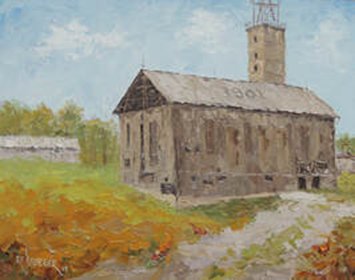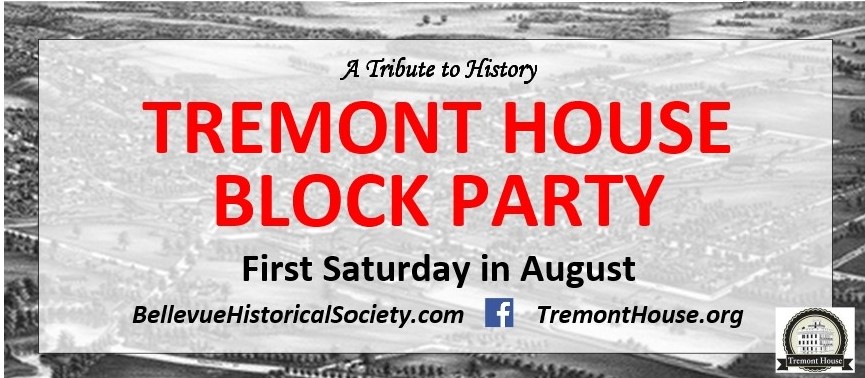
 Auction at The Tremont House Block Party on August 3rd will feature four of Bob Kroeger’s paintings, representing barns in Erie and Huron Counties, to be auctioned, with proceeds benefiting both the Historical Society and Art at 106, Bellevue’s local Artists’ Guild and Gallery Shop. Erie County barns are the Pickett Cherry Barn, now dismantled, which drew customers from all surrounding states to its Portland Rd site, and on Strecker Road, the Tommas barn, a marvelous old fellow with an empty corn crib that begged to be full again, which the painting complied. In Huron County, the Schwiefurt barn on Sandhill Road which rocked to many dancing feet over the years, and the Roeder barn on Route 20, west of Monroeville, recording its racing history as well as its farming origins.
Auction at The Tremont House Block Party on August 3rd will feature four of Bob Kroeger’s paintings, representing barns in Erie and Huron Counties, to be auctioned, with proceeds benefiting both the Historical Society and Art at 106, Bellevue’s local Artists’ Guild and Gallery Shop. Erie County barns are the Pickett Cherry Barn, now dismantled, which drew customers from all surrounding states to its Portland Rd site, and on Strecker Road, the Tommas barn, a marvelous old fellow with an empty corn crib that begged to be full again, which the painting complied. In Huron County, the Schwiefurt barn on Sandhill Road which rocked to many dancing feet over the years, and the Roeder barn on Route 20, west of Monroeville, recording its racing history as well as its farming origins.
The Tremont House Block Party is held on North West Street and in the alley behind the Tremont House, in the center of Bellevue, from 3 to 8 p.m. The paintings will be auctioned at 5:00, by Baker, Bonnigson Auctioneers. Join us for the festivities! Food, live music, wine and craft beer tastings, historic displays, a beam signing in the Tremont House, and raffles round out the events of the day.
Click Here to Print Absentee Bid Form
Click Here to Print Phone Bid Form
“Prisoners of War” (pictured above)
In the spring of 2018 – a year before my barn tour of Erie County – my barn scout Mel sent me a photo of this unusual barn and told me its story, which was the first time I’d heard that the United States took in POWs during WWII. But let’s begin at the beginning.
The barn – now dismantled – had a slate roof with the date of 1901, probably signifying when the barn was built. The farm may have been started earlier than that, as many were in Ohio’s northwest. And the original family may have been the Ohlemachers.
But eventually the Picketts took over the farm and planted many orchards of cherry trees – all kinds of them – sour, sweet, and in-between varieties. By the 1930s the trees were ready for harvest, which began a family tradition and gave work to many, not only locals but also to migrant workers traveling from one site to another. According to 87-year-old Bill Oddo, a local historian and founding member of the Bellevue Historical Society, whom I interviewed, each morning a flatbed truck would pick up workers throughout the region and transport them to the orchards during picking season, which lasted five to six weeks each summer. The migrant workers from out of town would be allowed to live in grain bins inside the barn. Mrs. Pickett would cook for them with her daughter Eileen, and eventually her granddaughters, Jean and Sue,helped with cooking and serving.
Bill, a teenager then, worked summers on this farm from about 1943 to 1947, picking cherries with his five brothers, closely supervised by their mother, who told them that their father didn’t make enough money in a factory job and that the extra cash would come in handy. Apparently, according to Bill, this amused his dad and may or may not have been true but it taught the children the value of hard work. Each child was supposed to pick 20 buckets – with a team goal of 100 buckets a day. One day, Bill said, they did out earn dad’s daily wages. But Bill – and many of the other teenaged boys – preferred working inside the barn where the cute girls worked – two or three dozen of them, preparing and pitting the cherries and then measuring them out into the buyers’ buckets or boxes. Boys will be boys.
The children also learned another valuable lesson. During the war years, American troops overseas simply could not handle the vast numbers of German and Italian POWs; so they transported them to our soil.
According to some sources, over 435,000 POWs – in 46 states and Alaska – were held here during those years, an exodus that began in August of 1942, when Britain could not handle its 273,000 prisoners. Churchill convinced our leaders to take 150,000 of them to start and, in the middle of 1943, when he visited Washington for a war conference, he shared the Queen Mary ocean liner with several thousand POWs.
During cherry harvest season, guards would load buses with prisoners from nearby Camp Perry in Port Clinton and bring them to the farm. Remember, in the early stages of the war the Germans, Italians, and Japanese were winning. Our Pacific fleet was ravaged. The Japanese occupied two of the Aleutian Islands – where my own father had been stationed – and the Germans were turning Britain into a bombed out graveyard. U-boats patrolled our eastern coast and torpedoed ships. So, many Americans weren’t pleased to provide food and shelter for these troops, though they treated them according to the requirements of the Geneva Convention. Unfortunately the Germans didn’t treat our POWs equally well in their camps.
According to locals who interacted with these POWs, including Bill and his family, each POW had a daily quota of 20 buckets of cherries. When the Germans reached their quota, they’d return to the bus and wait until it was time to return to Camp Perry. On the other hand, the Italian POWs were more amiable than their stoic German allies and, sharing a common culture with local Italian immigrants, many returned to settle in these counties after the war.
Behind the barn site stands a large cement tower with metal rigging and antennas, a structure that, according to Bill, the government built in 1946. My barn scouts explained that it was a booster radio transmitter that was used to enhance signals between Cleveland, Toledo, and Detroit.
But all good things come to an end and eventually cherry trees stop bearing fruit – usually after 15-30 years. Summer work shut down and the trees became ornamental. Farm ownership passed from patriarch Harold Pickett to his son Charles. Around 2010 the land was bulldozed, removing the trees, and the farm was sold at auction in 2012, when present owner Kevin Schaeffer purchased it. A history buff himself, and mindful of the heritage he inherited when he bought the farm, Kevin saved some barn siding – after the barn was dismantled in 2018 – and provided it for the framing of this painting, one that’s captured a story of our past, a memory of the POWs who once worked here, and another reminder of the brave men and women who captured them during WWII. Yes, that was the Greatest Generation. Let’s never forget them.
For more information on artist Robert Kroeger, go to https://barnart.weebly.com/




